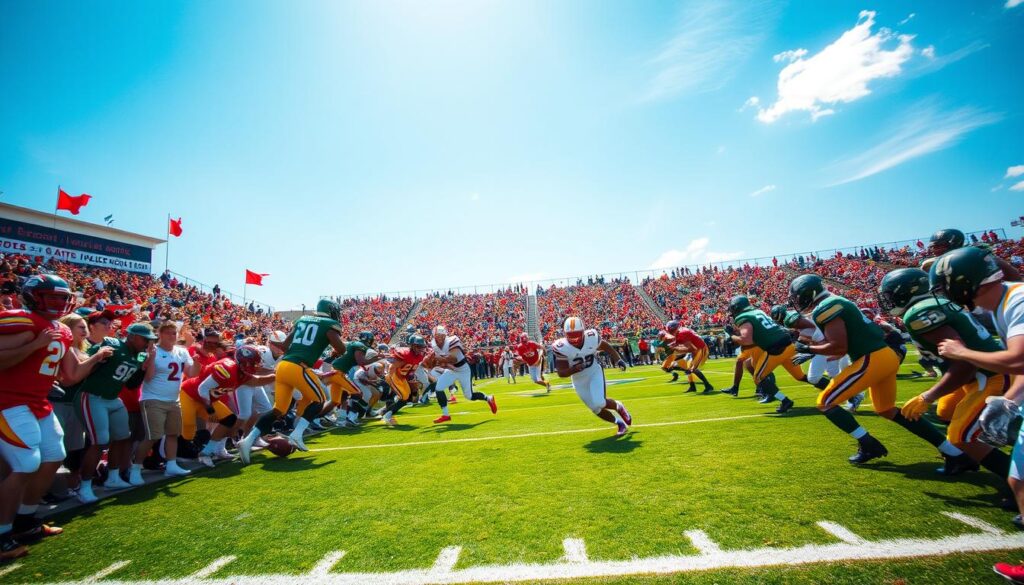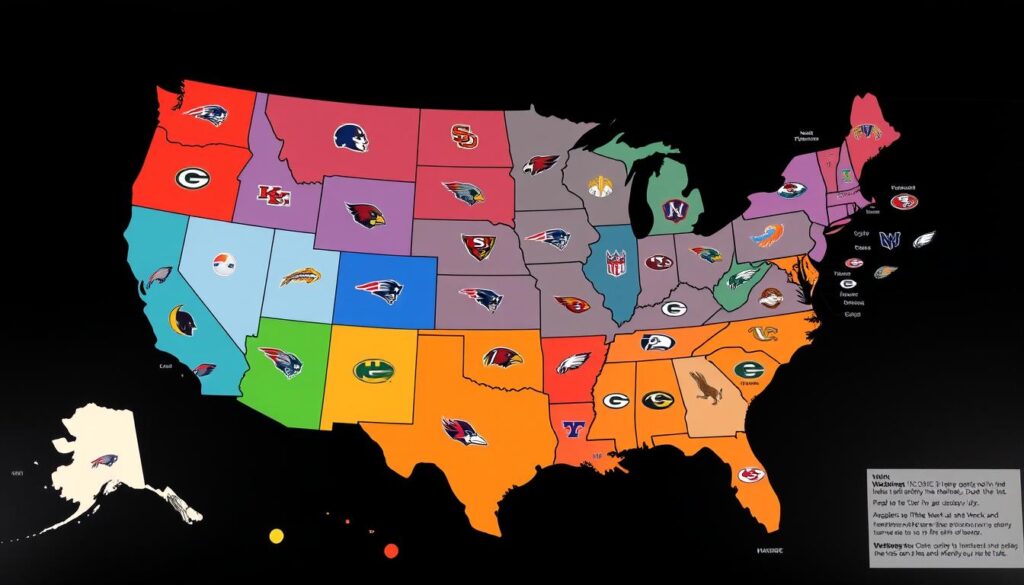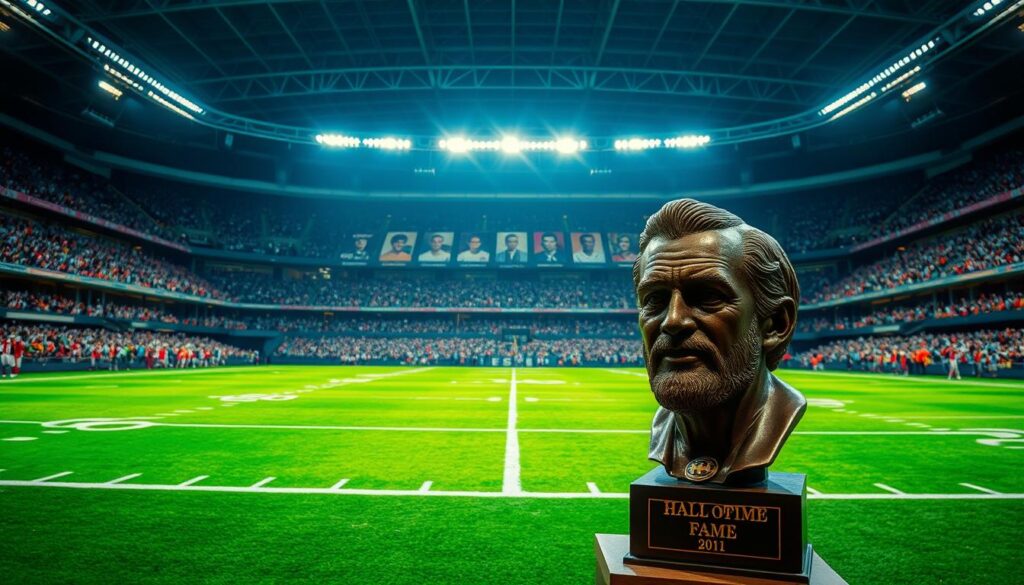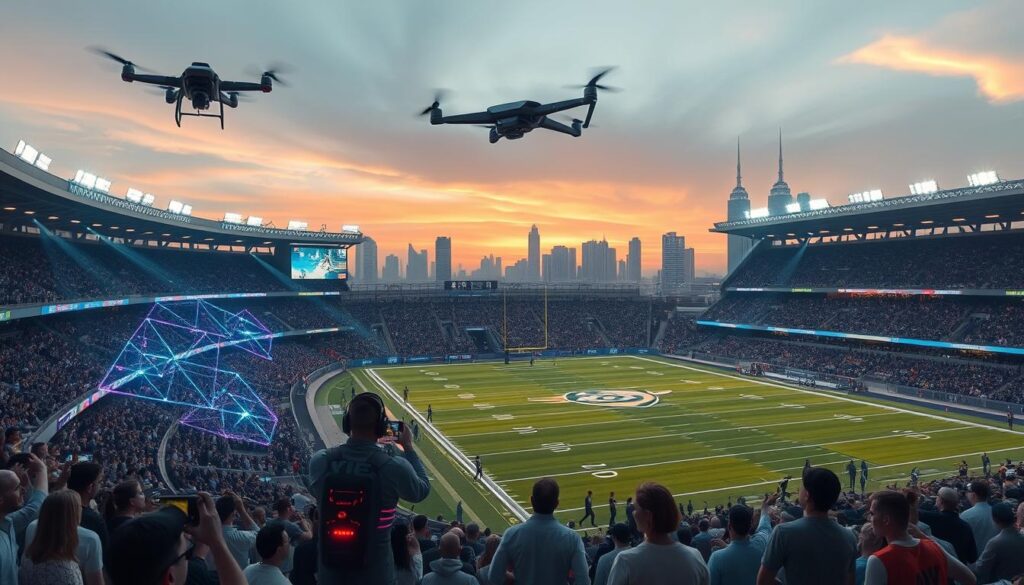Football, also known as American football, is the most loved sport in the United States. It’s a team sport played by two sides of 11 players each. They try to move an oval-shaped ball down a field to score points.
The game mixes strategy, athleticism, and tradition. It draws millions of fans across the country.

Key Takeaways
- Football is the most popular sport in the United States, with a rich history and passionate fan base.
- The game combines elements of strategy, athleticism, and tradition, making it a unique and thrilling spectacle.
- Football is played between two teams of 11 players each, who try to advance an oval-shaped ball down a field to score points.
- The sport has its own set of rules, positions, and strategies that set it apart from other sports like soccer (known as football in many countries).
- The National Football League (NFL) is the premier professional football league in the US, featuring some of the best players and teams in the world.
What is Football?
Football is a sport that started in the 19th century. It came from rugby and soccer but has its own rules and gameplay. This makes it a unique sport.
The Origins of the Game
The modern game of football began in the 1800s. It started in colleges and universities in the United States. It was inspired by rugby and soccer but became its own sport with its own rules and strategies.
Football vs. Soccer: Distinguishing the Two
Many people think football and soccer are the same, but they are not. They both have a ball and a field, but the gameplay and rules are different. In football, players use their hands to pass, carry, and catch the ball. Soccer players mostly use their feet.
Football also has a more complex system of downs, scoring, and player positions. This makes it different from soccer.
| Football | Soccer |
|---|---|
| Played with hands and feet | Played primarily with feet |
| Downs and possession changes | Continuous play with no possession changes |
| Specialized player positions | Fluid player positions |
| Quarterback leads the offense | No designated leader, team-based strategy |
Football’s unique features make it a captivating sport. It has a rich history and a dedicated fan base in the United States and worldwide.
The Playing Field
The football field is the heart of the game, where action happens and skills are shown. Knowing the field’s dimensions and markings is key for players and fans.
Dimensions and Markings
The field is 100 yards long and 53 1/3 yards wide. It’s a rectangle split into two halves by the midfield line. Yard lines, 10 yards apart, help everyone follow the game.
- The field is 100 yards (91.44 meters) long and 53 1/3 yards (48.8 meters) wide.
- The midfield line is marked at the 50-yard line, dividing the field into two equal halves.
- Yard lines are spaced 10 yards apart, creating a visual grid on the football field.
The field also has hash marks, goal lines, and end zones. These markings give players, officials, and fans important info. They help everyone know where the ball is and how the game is going.
“The football field is the canvas upon which the game’s drama is painted. Its precise dimensions and markings are the foundation upon which the epic battles of the gridiron are fought.”
Knowing the football pitch‘s dimensions and markings helps fans and players. It lets them see the game’s strategic and spatial aspects more clearly.
Key Players and Positions
In the game of football, teams have many specialized positions. Each one is key to the team’s strategy and success. The quarterback, running backs, and wide receivers are among the most important.
Quarterback: The Leader on the Field
The quarterback leads the offense. They direct plays, make quick decisions, and pass the ball to teammates. Quarterbacks need to know the game well, make smart choices, and stay calm under pressure.
Running Backs: Carrying the Ball
Running backs carry the ball downfield. They use their speed, agility, and strength to gain yards. They are crucial to the offense, adding a strong ground game to the passing attack.
Wide Receivers: Catching the Passes
Wide receivers catch passes from the quarterback. They use their speed, hands, and route skills to find open spots in the defense. Their catches help the team get closer to the end zone.
| Position | Key Responsibilities | Attributes |
|---|---|---|
| Quarterback | Directing the offense, making decisions, delivering the ball | Decision-making, leadership, accuracy |
| Running Back | Carrying the ball, gaining yardage, providing a ground attack | Speed, agility, power |
| Wide Receiver | Catching passes, finding open spaces, making crucial catches | Speed, hands, route-running |
Offense and Defense Strategies
Football is a game filled with complex strategies. The offense tries to move the ball down the field and score. The defense works to stop them and take the ball back.
The offense uses different plays and formations to find weak spots in the defense. They aim to run the ball hard, pass accurately, and confuse the defense with complex plays.
- Passing Plays: Quarterbacks lead complex passing plays. They use short, medium, and long passes to find open receivers.
- Running Plays: Running backs and other players use their speed, agility, and strength to gain yards.
- Offensive Formations: Teams use various formations like the West Coast Offense and the Spread Offense. Each has its own strengths.
The defense uses many tactics to stop the offense and take the ball. They use aggressive formations, blitzes, and tight coverage to limit the offense’s options.
| Defensive Strategies | Description |
|---|---|
| Blitz Packages | Defensive coordinators create complex blitzes to pressure the quarterback and disrupt the offense. |
| Coverage Schemes | Defensive players use man-to-man, zone, and hybrid coverage to stop the passing game. |
| Defensive Formations | Teams use different formations like the 4-3 and the Nickel defense. Each has its own strengths and weaknesses. |
The battle between the offense’s strategies and the defense’s countermeasures is what makes football exciting. As teams keep changing their tactics, the game becomes more thrilling for fans and analysts.
Football Rules and Regulations
Football has clear rules and regulations. These cover scoring, penalties, and infractions. They ensure the game is fair and exciting.
Scoring System
Points are awarded for achievements in football. The main ways to score include:
- Touchdown (6 points): When a player carries the ball into the end zone or catches a pass there.
- Field Goal (3 points): When a player kicks the ball through the uprights.
- Extra Point (1 or 2 points): After a touchdown, by kicking (1 point) or running/passing (2 points).
Penalties and Infractions
Football has penalties and infractions. These are called by officials during the game. Examples include:
- Holding: Grabbing or restricting an opposing player illegally.
- Offsides: Starting before the ball is snapped.
- Pass Interference: Blocking a receiver’s catch.
- Unsportsmanlike Conduct: Poor sportsmanship or behavior.
Penalties can lead to yardage loss, a first down for the other team, or even a player’s ejection.
| Penalty | Description | Consequence |
|---|---|---|
| Holding | Illegally grabbing or restricting an opposing player. | Loss of 10 yards |
| Offsides | Being in the neutral zone before the snap of the ball. | Loss of 5 yards |
| Pass Interference | Impeding a receiver’s ability to catch a pass. | Awarded first down to the opposing team |
| Unsportsmanlike Conduct | Displaying poor sportsmanship or behavior. | Loss of 15 yards, potential ejection from the game |
“The rules of football are simple, and the game is intricately complex.” – Damon Runyon
The National Football League (NFL)
The National Football League (NFL) is the top league for American football in the United States. It has 32 teams split into two main groups: the National Football Conference (NFC) and the American Football Conference (AFC). Each group has four divisions.
Teams and Divisions
The 32 NFL teams are divided into the following groups:
- NFC East: Dallas Cowboys, New York Giants, Philadelphia Eagles, Washington Commanders
- NFC North: Chicago Bears, Detroit Lions, Green Bay Packers, Minnesota Vikings
- NFC South: Atlanta Falcons, Carolina Panthers, New Orleans Saints, Tampa Bay Buccaneers
- NFC West: Arizona Cardinals, Los Angeles Rams, San Francisco 49ers, Seattle Seahawks
- AFC East: Buffalo Bills, Miami Dolphins, New England Patriots, New York Jets
- AFC North: Baltimore Ravens, Cincinnati Bengals, Cleveland Browns, Pittsburgh Steelers
- AFC South: Houston Texans, Indianapolis Colts, Jacksonville Jaguars, Tennessee Titans
- AFC West: Denver Broncos, Kansas City Chiefs, Las Vegas Raiders, Los Angeles Chargers
Each division has four teams. They play each other all season. The goal is to make it to the NFL playoffs and win the Super Bowl.

College Football Traditions
College football is a big part of American culture. Universities all over the country have their own traditions and rivalries. These traditions include iconic fight songs and tailgating rituals.
Rivalries and Bowl Games
College football is known for its intense rivalries. Games like the Iron Bowl between Alabama and Auburn are very popular. They often decide who goes to the conference championships and bowl games.
At the end of the season, teams compete for spots in big bowl games. Games like the Rose Bowl and Sugar Bowl are exciting. They help make the season memorable for players and coaches.
| Major College Football Rivalries | Prominent Bowl Games |
|---|---|
| The Iron Bowl (Alabama vs. Auburn) The Red River Showdown (Texas vs. Oklahoma) The Army-Navy Game The Civil War (Oregon vs. Oregon State) The Backyard Brawl (West Virginia vs. Pittsburgh) | Rose Bowl Sugar Bowl Fiesta Bowl Orange Bowl Cotton Bowl |
These traditions, rivalries, and bowl games bring people together. They create a sense of community and pride. This makes college football a beloved part of American culture.
Football Equipment and Gear
Football is a beloved sport in America. It needs special equipment and gear for safety and performance. The uniform, including helmets and pads, is key to protecting players from the game’s physical demands.
Helmets: The Cornerstone of Protection
The football helmet is crucial for protecting players’ heads. It has advanced safety features like shock-absorbing padding and strong facemasks. These help reduce the risk of concussions and head injuries.
Pads: Guarding the Body
Players also wear protective pads for their body. Shoulder, thigh, and knee pads absorb the impact of tackles. This lets players compete safely and confidently.
The Complete Uniform
The uniform includes more than just helmets and pads. It also has jerseys, pants, and cleats. These are made for comfort, flexibility, and grip. They help players move fast and well on the field.
| Football Equipment | Purpose | Key Features |
|---|---|---|
| Helmet | Protect the head from impacts | Shock-absorbing padding, reinforced facemask |
| Shoulder Pads | Safeguard the shoulders and upper body | Rigid shell, lightweight design |
| Thigh and Knee Pads | Protect the legs from collisions | Flexible, impact-resistant padding |
| Jerseys and Pants | Provide comfort and mobility | Breathable, moisture-wicking fabrics |
| Cleats | Enhance traction on the field | Durable soles with strategically placed studs |
The football uniform shows the sport’s focus on safety and performance. As football evolves, these protective items will remain vital for player safety.
Developing Football Skills
To become a skilled football player, you need dedication, discipline, and a drive to always get better. Players must work hard to master the basics and improve their advanced skills. This means lots of training and practice to reach their top performance on the field.
Training and Practice Drills
Good football training mixes physical conditioning, skill building, and game-like drills. Players work on their speed, agility, strength, and endurance through various drills. This helps them get better at the game.
- Speed and Agility Drills: These exercises boost players’ quickness, footwork, and ability to change direction fast. Examples include ladder drills, cone drills, and shuttle runs.
- Strength and Conditioning: Weightlifting, plyometrics, and other exercises build muscle power and explosiveness needed for football.
- Position-Specific Drills: Quarterbacks, running backs, wide receivers, and others practice skills like throwing, catching, and ball handling.
- Game-Situation Drills: Players practice in scrimmages and simulated game scenarios to use their skills in a real game setting.
Being consistent is crucial for improving football skills. Regular practice, both alone and with the team, helps players learn and apply the right techniques. By sticking to a structured training plan, players can reach their full potential and perform their best on game day.
| Drill | Purpose | Duration |
|---|---|---|
| Ladder Drills | Improve footwork, agility, and coordination | 10-15 minutes |
| Plyometric Exercises | Develop explosive power and strength | 15-20 minutes |
| Passing Accuracy Drills | Enhance quarterback’s throwing precision | 20-25 minutes |
| Tackling Technique Drills | Refine proper tackling form and mechanics | 15-20 minutes |
“The more you sweat in practice, the less you bleed in battle.” – Richard Marcinko
Football Legends and Hall of Famers
American football has a rich history filled with legendary players, coaches, and figures. The Pro Football Hall of Fame in Canton, Ohio, honors the greatest who have shaped the game.
Iconic quarterbacks like Joe Montana, Tom Brady, and Peyton Manning have amazed fans with their skills. Running backs like Walter Payton, Barry Sanders, and Emmitt Smith are celebrated for their athleticism and records.
Defensive stars like Lawrence Taylor, Ray Lewis, and Deion Sanders are known for their game-changing plays. Wide receivers Jerry Rice, Randy Moss, and Larry Fitzgerald have wowed fans with their catches.
Celebrated coaches like Vince Lombardi, Bill Belichick, and Bill Walsh are praised for their strategic genius. These individuals, along with many others, have left a lasting impact on football. They inspire players and fans to this day.
“Football is a game of inches. If you ain’t got the inches, you ain’t got a chance.” – Vince Lombardi, Hall of Fame Coach
The Pro Football Hall of Fame is a temple honoring the game’s greatest contributors. It ensures their legacies inspire and captivate football fans for generations.

The Spectacle of the Super Bowl
The Super Bowl is the top event in football, watched by millions around the world. It’s known for its exciting games, amazing halftime shows, and famous commercials. These elements make the Super Bowl a big deal in culture.
Halftime Shows and Commercials
The halftime show is a big deal, featuring top music stars. Fans have seen great performances by The Weeknd, Jennifer Lopez, and more. These shows are a big part of the event, showing off the latest in music and entertainment.
The commercials during the Super Bowl are also a highlight. Brands spend a lot to make ads that grab everyone’s attention. These ads range from touching stories to fun celebrations, becoming a tradition that people love to talk about.
| Year | Halftime Performer | Notable Commercials |
|---|---|---|
| 2022 | Dr. Dre, Snoop Dogg, Eminem, Mary J. Blige, Kendrick Lamar, 50 Cent | Coinbase, Uber Eats, Chevrolet |
| 2021 | The Weeknd | Jeep, Paramount+, Cadillac |
| 2020 | Jennifer Lopez, Shakira | Budweiser, Hyundai, Microsoft |
The Super Bowl has grown into more than just a game. The halftime shows and commercials are key parts of the event. They captivate audiences and make a lasting impact, even after the game ends.
“The Super Bowl is more than just a football game; it’s a true spectacle that brings people together from all walks of life.”
Fantasy Football and Fan Engagement
The world of football is more than just the game itself. It has captured the hearts of fans with fantasy leagues and digital platforms. Fantasy football has become a big deal, letting fans get closer to the game in new ways.
Fantasy football leagues let fans pick real players for their virtual teams. They score points based on how well those players do in games. This makes game day even more exciting and strengthens the bond between fans and their teams.
Social media and digital platforms have changed how fans connect with football. Now, fans can follow their teams and players live. They share their love for the game with others worldwide. From tweeting during games to joining online communities, the digital world has changed how we enjoy football.
| Key Trends in Fan Engagement | Impact |
|---|---|
| Fantasy Football Leagues | Increased personal investment and connection with the sport |
| Social Media Platforms | Enhanced real-time interaction and community-building among fans |
| Streaming Services | Improved access to live games and highlights for fans |
| Mobile Apps | Instant updates, stats, and engagement opportunities for fans on the go |
The digital world is always changing, and so is football fan engagement. The future looks bright, with even more ways for fans to connect with the game they love.
“Football is more than just a game – it’s a way of life for millions of fans around the world. The digital revolution has amplified their passion and connection to the sport in remarkable ways.”
The Future of Football
American football is changing, facing both challenges and chances. New tech, like better player tracking and digital stats, could make the game safer and better for players. But, worries about player safety, especially concussions and long-term health, are big concerns.
Technological Advancements and Safety Concerns
The future of football will be shaped by tech and player safety. New gadgets, smart helmets, and data tools are changing how teams check on player health and how well they play. These tools give insights into how players move, the impact of hits, and if they might have concussions. This helps coaches and medical teams make safer choices for players.
But, concussions and brain health worries still shadow the sport. The NFL and college football have started to improve concussion rules and care for players. Yet, the lasting effects of head injuries are still a big worry. Doctors and researchers are working hard to understand these effects and find better ways to prevent and treat them.
As the football world deals with these safety issues, there’s a push for new solutions that put player health first. The future of football will likely find a balance between keeping the game’s traditions and using technological advances to make it safer and cut down on concussions.

“The future of football is not just about winning games, but about ensuring the long-term health and well-being of the players who make the game possible.”
Conclusion
Football is America’s favorite sport, and its legacy is strong. It started small but grew into a big part of our culture. The game mixes strategy, athleticism, and tradition, making it exciting for fans.
As football grows, it uses new tech and works on safety. This makes its future look bright. It will keep inspiring and uniting people across the country.
The history and fan culture of football show its big impact on America. It brings excitement and togetherness, whether it’s a college game or the Super Bowl. Fans look forward to the next chapter of football, ready for its triumphs and challenges.
Football is more than just a game; it’s a symbol of unity and passion. Looking back, we see its incredible journey. Football will keep captivating and inspiring Americans for many years.
FAQ
What is the objective of American football?
American football aims to move a ball down the field. Teams score by crossing the opponent’s goal line or kicking the ball through the goal posts. The team with the most points wins the game.
What are the main positions in a football team?
Key positions include the quarterback, running backs, and wide receivers. There are also linemen, linebackers, defensive backs, and kickers.
How is scoring done in football?
Points can be scored in several ways. Touchdowns are worth 6 points. Field goals are 3 points. Extra points can be 1 or 2 points after a touchdown.
What is the difference between the NFL and college football?
The NFL and college football differ in several ways. The NFL has professional players, while college football has amateur athletes. Rules and academic focus also vary.
What is the Super Bowl and why is it so important?
The Super Bowl is the NFL’s championship game. It’s the biggest event in American football, watched by millions. It features famous halftime shows and commercials.
How do teams and players prepare for a football game?
Teams prepare through training, practice, and film study. They focus on physical conditioning and strategic planning. This helps them outperform opponents.
What are the main safety concerns in football?
Safety concerns include concussions and long-term health issues. Efforts are made to protect players and reduce these risks.
How has technology impacted the sport of football?
Technology has changed football a lot. It helps with officiating, player performance, and safety. This includes video replay, analytics, and protective equipment.
What are some of the most famous rivalries in football?
Famous rivalries include the Army–Navy Game and the Iron Bowl. The Dallas Cowboys vs. Washington Commanders is another notable matchup.
How do fans engage with the sport of football?
Fans enjoy football in many ways. They attend games, watch broadcasts, and join fantasy leagues. Social media also plays a big role in the football experience.





